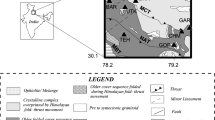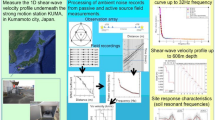Abstract
Approximately 4000 people were killed due to collapse of buildings in downtown Adapazari during the 1999 Izmit, Turkey earthquake (Mw = 7.4). The downtown is located on a deep sedimentary basin, so-called Adapazari basin. We study site effects of the Adapazari basin based on strong- and weak-motion data obtained by a temporary array observation deployed in and around the Adapazari basin after the earthquake. Four moderate-size aftershocks (M4.6–M5.8) are selected in our study. We evaluate the S-wave amplifications in the basin by using the traditional spectral ratio method. The spectral ratios show that the S waves are considerably amplified in the frequency range of 0.5 to about 5 Hz at the basin sites, but are apparently de-amplified at frequencies higher than about 10 Hz. We make a quantitative interpretation of the empirical amplifications based on the S-wave velocity structures at the stiff-soil reference site as well as at the basin sites; these structures were estimated by the microtremor array measurements. Through the interpretation, we confirm that the amplifications at low frequencies are attributed to the thick sedimentary layers in the Adapazari basin and that the apparent de-amplifications at high frequencies are partly due to the reference site response. In addition to the considerable S-wave amplifications, the basin site records show long-period (about 2 sec) later phases after the S-wave arrival; these later phases are basin-transduced surface waves that are originated from the source and transmitted into the basin. The predominant period of these waves apparently depends on the earthquake magnitude. We conclude that heavy damage in downtown Adapazari during the 1999 Izmit earthquake was caused not only by strongly amplified S-waves but also by long-period basin surface waves of long duration.
Similar content being viewed by others
References
Aki, K. and Richard, P.G., 1980, Quantitative Seismology, Volume: 1, W. H. Freeman and Company Press, San Francisco, 557 p.
Bakir, S., Sucuoglu, H. and Yilmaz, T., 2002, An overview of local site effects and the associated building damage in Adapazari during the 17 August 1999 Izmit Earthquake, Bull. Seism. Soc. Am. (Special Issue) 92(1), 509–526.
Bonilla, L.F., Steidl, J.H., Lindley, G.T., Tumarkin, A.G. and Archuleta, R.J., 1997, Site amplification in the San Fernando Valley, California: Variability of site-effects estimation using the S Wave, Coda, and H/V Methods, Bull. Seism. Soc. Am. 87(3), 710–730.
BSSC, 1994, NEHRP recommended provisions for seismic regulations for new buildings, Part 1- Provisions, FEMA 222A, Federal Emergency Management Agency, 299 p.
Devlet Su Isleri (DSI), 1983, Asagi Sakarya ovasi hidrojeolojik etud raporu (in Turkish).
Field, E.F., 1996, Spectral amplification in a sediment-filled valley exhibiting clear basin-edge-induced waves, Bull. Seism. Soc. Am. 86(4), 991–1005.
Frankel, A.D., Carver, D., Cranswick, E., Meremonte, M., Bice, T. and Overturf, D., 1999, Site response for Seattle and source parameters of earthquakes in the Puget Sound region, Bull. Seism. Soc. Am. 89, 468–483.
Frankel, A.D., Carver, D.L. and Williams, R.A., 2002, Nonlinear and linear site response and basin effects in Seattle for the M6.8 Nisqually, Washington, Earthquake, Bull. Seism. Soc. Am. 92(6), 2090–2109.
Hartzell, S., Carver, D., Cranswick, E. and Frankel, E., 2000, Variability of site response in Seattle, Washington, Bull. Seism. Soc. Am. 90(5), 1237–1250.
Haskell, N.A., 1960, Crustal reflection of plane SH waves, J. Geophys. Res. 65, 4147–4150.
Haskell, N.A., 1962. Crustal reflection of plane P and SV waves, J. Geophys. Res. 67, 4751–4765.
Japan Reconnaissance Team, 2000, Report on the Damage Investigation of the 1999 Kocaeli Earthquake in Turkey, Architectural Inst. of Japan; Japan Soc. of Civil Engineers; The Japanese Geotechnical Society (CD-Rom).
Kawase, H. and Aki, K., 1989, A Study on the response of a soft basin for incident S, P and Rayleigh waves with special reference to the long duration observed in Mexico City, Bull. Seism. Soc. Am. 79, 1361–1382.
Kawase, H., 1993, Effects of surface and subsurface irregularities. In: Earthquakes and Ground Motions, Part I, Chapter 3, Section 3.3, The Research Subcommittee on Earthquake Ground Motion, The Architectural Institute of Japan, pp. 118– 155.
Kocaeli Universitesi Yeralti Arastirma Birimi, 1998, Sakarya (Adapazari) Anakaya Tespit Projesi Raporu (in Turkish).
Komazawa, M., Morikawa, H., Nakamura, K., Akamatsu, J., Nishimura, K., Sawada, S., Erken, A. and Onalp, A., 2002, Bedrock structure in Adapazari, Turkey—A possible cause of severe damage by the Kocaeli Earthquake, Soil Dynamics and Earthq. Eng. 22, 829–836.
Kudo, K., Kanno, T., Okada, H., Ozel, O., Erdik, M., Sasatani, T., Higashi, S., Takahashi, M. and Yoshida, K., 2002, Site-specific issues for strong ground motions during the Kocaeli, Turkey, Earthquake of 17 August 1999, as inferred from array observations of microtremors and aftershocks, Bull. Seism. Soc. Am. (Special Issue) 92(1), 448–465.
Kudo, K., 2004. Research on practical use of array analysis of microtremors for survey of shallow soil stratum in the framework of performance-based design of building, Report of Research Project, Grant-in-Aid for Scientific Research, No. 14350294 (in preparation).
Mineral Research and Exploration Institute of Turkey (MREI), 2000, Geologic map of Bursa (scale 1/100000), index number: G22.
Okada, H., 2003, The microtremor survey method. Geophysical Monograph Series, 12, Society of Exploration Geophysicists, pp. 135.
Ozel, O., Cranswick, E., Meremonte, M., Erdik, M. and Safak, E., 2002, Site effects in Avcilar, west of Istanbul, Turkey, from strong- and weak-motion data, Bull. Seism. Soc. (Special Issue) 92(1), 499–508.
Ozel, N., Sasatani, S. and Ozel, O., 2003, A study of strong-ground motions during the largest aftershock (Mw = 5.8) of the 1999 Kocaeli, Turkey earthquake, Tectonophysics (in press).
Safak, E. and Erdik, M. (Coordinators), 2000, Recorded mainshock and aftershock motions, Earthquake Spectra, Suppl. A 16, 97–112.
Sancio, R.B., Bray, J.D., Stewart, J.P., Youd, T.L., Durgunoglu, H.T., Onalp, A., Seed, R.B., Christensen, C., Baturay, M.B. and Karadayilar, T., 2002, Correlation between ground failure and soil conditions in Adapazari, Turkey, Soil Dynamics Earthq. Eng. 22, 1093–1102.
Satoh, T., Kawase, H. and Sato, T., 1995, Evaluation of local site effects and their removal from borehole records observed in the Sendai region, Japan, Bull. Seism. Soc. Am. 85, 1770–1789.
Steidl, J.H., Tumarkin, A.G. and Archuleta, R.J., 1996, What is a reference site? Bull. Seism. Soc. Am. 86, 1733–1748.
Wright, T., Parsons, B. and Fielding, E., 2001, The 1999 Turkish earthquakes: Source parameters from InSAR and observation of triggered slip, Proceeding of Symposia on Seismotectonics of the North-Western Anatolia-Aegean and Recent Turkish earthquakes, p. 55.
Author information
Authors and Affiliations
Corresponding author
Rights and permissions
About this article
Cite this article
Oguz, O., Sasatani, T. A site effect study of the Adapazari basin, Turkey, from strong- and weak-motion data. J Seismol 8, 559–572 (2004). https://doi.org/10.1007/s10950-004-3328-8
Received:
Accepted:
Issue Date:
DOI: https://doi.org/10.1007/s10950-004-3328-8




